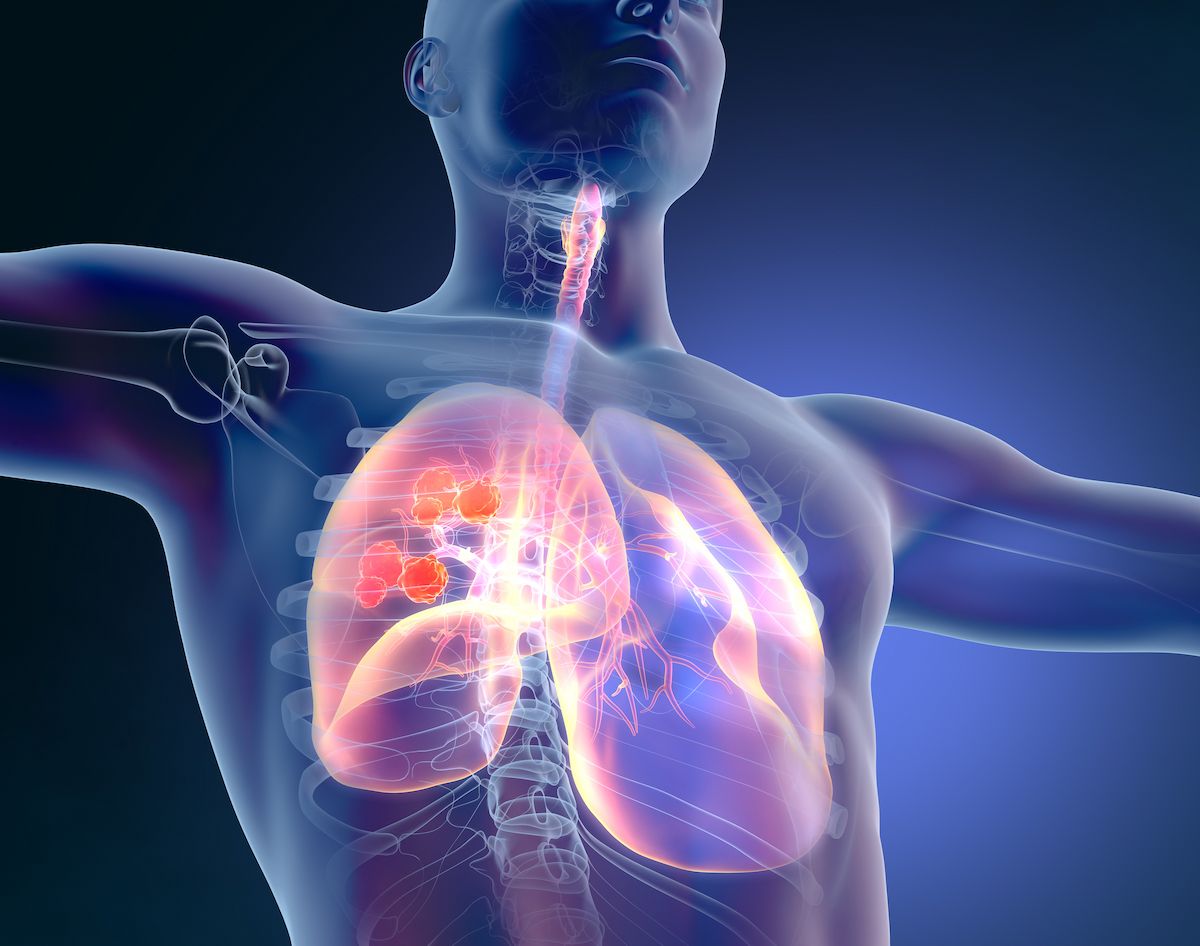Sevabertinib monotherapy elicited robust and durable responses as therapy for patients with HER2-mutant advanced non–small cell lung cancer (NSCLC) in both front-line and pretreated settings, according to results from the phase 1/2 SOHO-01 trial (NCT05099172) presented at the European Society for Medical Oncology (ESMO) Congress 2025.1 Results were simultaneously published in the New England Journal of Medicine.2
In cohort D (n = 81), which included patients who were previously treated, the objective response rate (ORR) by blinded independent central review (BICR) was 64% (95% CI, 53%-75%), with 2% achieving complete responses (CRs), 62% achieving partial responses (PRs), 25% having stable disease, 7% having progressive disease, and 4% not being evaluable. The disease control rate (DCR) was 81% (95% CI, 71%-89%).
The median duration of response (DOR) was 9.2 months (95% CI, 6.3-13.5), with a 12-month DOR rate of 42%; the median progression-free survival (PFS) was 8.3 months (95% CI, 6.9-12.3), with a 12-month PFS rate of 44%.
With a median follow-up of 13.8 months (range, 1-32), the median duration of treatment (DOT) was 9.9 months (range, 0-32). A total of 30% of patients had ongoing treatment, 20% had a treatment duration of more than 15 months, and responses were maintained after dose reductions or interruptions.
Subgroup analyses revealed that ORR was consistent across all subgroups, such as age, sex, race, number of previous systemic treatments, presence of baseline brain metastases, and receipt of prior platinum chemotherapies.
In patients with non-squamous NSCLC and HER2 tyrosine kinase domain (TKD) mutations (n = 70), the ORR by BICR was 71%, and the median PFS was 9.6 months (95% CI, 6.9-14.7). In patients with HER2 Y772_A775dupYVMA alterations (n = 49), the ORR by BICR was 78%; in those with YVMA, the median PFS was 12.2 months (95% CI, 6.9-16.4), and in those with other TKD mutations, the median PFS was 7.0 months (95% CI, 4.0-not estimable [NE]).
Additionally, in cohort E, which included patients who received prior treatment with HER2 antibody drug conjugates (n = 55), the ORR by BICR was 38% (95% CI, 25%-52%), with 5% achieving CRs, 33% achieving PRs, 42% having stable disease, 13% having progressive disease, and 7% not being evaluable; the DCR was 71% (95% CI, 57%-82%).
The median DOR was 8.5 months (95% CI, 5.6-16.4), with a 12-month DOR rate of 29%, and the median PFS was 5.5 months (95% CI, 4.3-8.3), with a 12-month PFS rate of 28%. The median follow-up was 11.6 months (range, 2-22).
In cohort F, which enrolled patients who were treatment-naïve (n = 73), the ORR by BICR was 71% (95% CI, 59%-81%), with 4% achieving CRs, 67% achieving PRs, 22% having stable disease, 3% having progressive disease, and 1% not being evaluable. The DCR was 89% (95% CI, 80%-95%).
The median DOR was 11.0 months (95% CI, 8.1-NE), and the median PFS was NE (95% CI, 9.6-NE). The median follow-up was 9.9 months (range, less than 1-15).
Further, brain metastases were present in 22% of patients in cohort D, 27% of cohort E, and 12% of cohort F. An analysis demonstrated systemic responses were similar in patients with and without brain metastases. In cohort D, patients with and without brain metastases had ORRs of 61% and 65%, respectively; in cohort E, the ORRs were 27% and 43%; and in cohort F, the ORRs were 78% and 70%.
In patients who had brain metastases at baseline in cohorts D, E, and F, post-baseline progression in the brain was observed in 22%, 20%, and 0%, respectively. In those with no brain metastases at baseline in cohorts D, E, and F, post-baseline progression in the brain was observed in 6%, 5%, and 3%, respectively.
“Sevabertinib demonstrated robust and durable responses in patients with HER2-mutant NSCLC in both pretreated and first-line settings. The most common [adverse] effect was diarrhea, which was manageable; there were no reported cases of interstitial lung disease (ILD) or pneumonitis,” said presenting study author Xiuning Le, MD, PHD, associate professor in the Department of Thoracic/Head and Neck Medical Oncology of the Division of Internal Medicine at the University of Texas MD Anderson Cancer Center, and coauthors, in the presentation.1 “These data support sevabertinib as a potential new targeted therapy for patients with HER2-mutant NSCLC.”
SOHO-01 enrolled patients with advanced NSCLC with HER2 or EGFR mutations; this analysis included data from the cohorts of patients with HER2 mutations. Cohort D enrolled patients who were previously treated, but naïve to HER2-targeted therapies; cohort E enrolled patients who were previously treated with HER2-targeted ADCs; and cohort F enrolled patients who were naïve to systemic therapy for advanced disease.
Across cohorts D, E, and F, the median age of patients was 60 years, 65 years, and 65 years, respectively, and 62%, 64%, and 78% had never smoked. Activating Y772_A775dupYVMA HER2 mutations were observed in 60%, 73%, and 79%, respectively, and 90%, 95%, and 97% had HER2 TKD mutations. Fam-trastuzumab deruxtecan-nxki (Enhertu) was received as previous anti-cancer therapy by 2%, 75%, and 0%, and chemotherapy was received by 96%, 80%, and 8%.
Treatment consisted of increasing oral doses of sevabertinib from 10 mg once daily to 40 mg twice daily, to identify the recommended dose for expansion.
The primary end point of the extension phase was ORR per RECIST v1.1 by BICR. Secondary end points included DOR, DCR, PFS, and safety and tolerability.
Regarding safety, drug-related adverse events (AEs) occurred in 69% of cohort D, 100% of cohort E, and 97% of cohort F; grade 3 AEs were reported in 36%, 31%, and 21%. Notably, grade 3 diarrhea events occurred in 23% of cohort D, 11% of cohort E, and 5% of cohort F. ILD or pneumonitis was not observed in any patients.
Biomarker data from SOHO-01 are being shared in a poster at ESMO on October 18, 2025.3
Sevabertinib is also being evaluated as a first-line therapy for patients with locally advanced or metastatic NSCLC with HER2 mutations in the ongoing phase 3 SOHO-02 trial (NCT06452277).
Disclosures: Dr. Le cited consultant roles for AbbVie, AstraZeneca, BlossomHill, Blueprint Medicines Corporation, Boehringer Ingelheim, Daiichi Sankyo Company, Eli Lilly and Company, Janssen Biotech, Merck KGaA, Novartis, Regeneron Pharmaceuticals, and Spectrum Pharmaceuticals.
References
- Le X, Kim TM, Dong X, et al. Sevabertinib (BAY 2927088) in advanced HER2-mutant non-small cell lung cancer (NSCLC): results from the SOHO-01 study. Presented at the 2025 European Society for Medical Oncology Congress. Presented at the 2025 ESMO Congress; October 17–20, 2025; Berlin, Germany. Abstract LBA75.
- Le X, Kim TM, Loong HH, et al. Sevabertinib in advanced HER2-mutant non–small-cell lung cancer. N Engl J Med. Published online October 17, 2025. doi:10.1056/NEJMoa2511065
- Girard N, Li L, Kim KM, et al. Molecular factors and ctDNA dynamics associated with clinical outcomes in patients with HER2-mutant NSCLC treated with sevabertinib (BAY 2927088): Exploratory analysis of the SOHO-01 study. Will be presented at the 2025 ESMO Congress; October 17–20, 2025; Berlin, Germany. Abstract 2001P.





